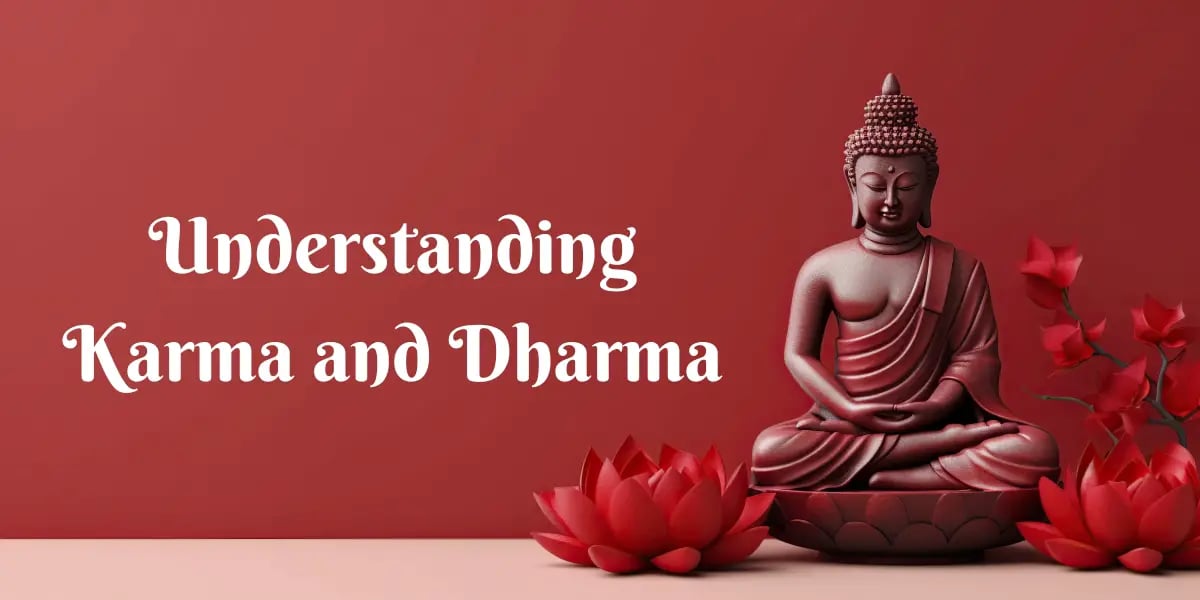Spiritual
Understanding Karma and Dharma: Elevate Your Spiritual Journey
1. Introduction: The Essence of Karma and Dharma
In the spiritual journey, karma and dharma are often seen as abstract concepts, but their impact on daily life is profound and tangible. Karma, commonly understood as the law of cause and effect, is more than just a cosmic ledger of good and bad deeds. It is an intricate web of energy that reflects not only our actions but also our intentions, thoughts, and even unspoken emotions. Dharma, on the other hand, is often simplified as “duty” or “righteous path.” However, it is much more dynamic—it represents the personal, societal, and cosmic roles we are meant to fulfill in alignment with the universe.
For those who engage in meditation and spiritual rituals, the understanding of karma and dharma goes beyond mere intellectual knowledge. It becomes an embodied practice that guides the way they live, think, and respond to the world. Yet, many in the spiritual community often overlook the deeper, more nuanced ways that these forces interact and shape our lives. The power of this lies not just in what happens to us externally, but in the subtle transformations they cause within—shaping our soul’s evolution, spiritual insights, and ultimate awakening.
What’s seldom discussed is how these forces are not fixed. Karma is not a rigid framework of punishment and reward, and dharma is not a static set of rules we must obey. Both are fluid, responding to our level of consciousness and spiritual maturity. As we evolve spiritually, so do our karmic patterns and dharmic duties. This shift isn’t something that is commonly highlighted in popular spiritual discourse, but it is crucial for those on a deeper path of self-realization.
Understanding this through this lens allows us to take greater responsibility for our spiritual journey. These aren’t abstract forces we are subjected to, but powerful tools we can consciously utilize to uplift ourselves, align with our true nature, and accelerate our spiritual growth.
Table of Contents
2. Karma: The Law of Cause and Effect

Karma is often reduced to a simplistic equation of “do good, receive good; do bad, receive bad.” While this is partially true, the real essence of karma runs far deeper, weaving through the subtle layers of our existence. Karma is not merely about visible actions—it encompasses our thoughts, intentions, and even the energies we emit unconsciously. For the spiritually inclined, understanding karma as a multidimensional force can be a game-changer in how one approaches personal growth, spiritual practices, and relationships.
The concept of karma is rooted in the idea that every action creates a ripple in the fabric of the universe. This ripple, in turn, affects both the external world and our internal landscape. What’s rarely considered is that karma also includes inaction. Sometimes, failing to act when required, or avoiding responsibility, can generate as much karmic weight as a misdeed. The universe responds not only to what we do, but to what we avoid doing out of fear, ego, or misunderstanding.
A unique aspect of karma seldom explored is the idea of karmic patterns. These patterns are like energetic blueprints formed by our repeated actions and behaviors, often spanning multiple lifetimes. They can manifest as recurring challenges or relationships in our current life, guiding us toward unresolved lessons. Spiritual practices like meditation and mindfulness can help us become aware of these patterns, giving us the opportunity to break free from negative cycles and consciously shape our future.
Another overlooked aspect of karma is its neutrality. Karma is not punitive or rewarding in the human sense. It doesn’t operate with moral judgment but instead follows the law of balance. Every action seeks equilibrium, and this is where the potential for spiritual transformation lies. Understanding this deeper neutrality helps us to stop seeing karma as a form of cosmic punishment and start recognizing it as a pathway for growth.
As we engage more consciously with karma, we can begin to use it as a tool for liberation rather than a force of destiny. By aligning our actions, thoughts, and emotions with higher spiritual principles, we can start to influence the kind of energy we send out into the world. This, in turn, allows us to uplift our karma, clearing the way for a more enlightened and peaceful life. The more intentional we become in this process, the more we gain mastery over our spiritual evolution, rather than feeling bound by it.
3. Dharma: The Path of Righteousness

At its core, the path of righteousness is about living in harmony with one’s true nature and the universal order. It serves as an inner compass, guiding us toward actions that align with our higher self while benefiting the greater good. This path is not a rigid set of duties or obligations tied to cultural or religious norms but is far more fluid and personalized, evolving as we grow spiritually. Rather than following external rules, it’s about staying true to our authentic selves.
One often overlooked aspect in spiritual discussions is how closely our choices intertwine with this path. Each person’s sense of purpose and responsibility is unique, shaped by their karmic journey, talents, circumstances, and spiritual calling. As we progress through different life stages, our purpose evolves, prompting us to regularly reassess our actions and adjust them to align with our changing mission. The spiritual journey is not about rigid adherence to a singular “right way” but rather about embracing the dynamic nature of our path moment by moment.
Another seldom discussed aspect is that this journey is not just about personal fulfillment but also about maintaining cosmic balance. When we stray from it—acting out of ego, fear, or selfishness—we disrupt this balance, leading to inner conflict and external challenges. These disturbances affect not only our spiritual well-being but also manifest emotionally, signaling that we are out of sync with our true purpose.
For those on a spiritual path, this journey serves as a profound guidepost. It helps us differentiate between actions born of higher consciousness and those driven by ego or societal pressures. To follow this path requires deep self-awareness and spiritual discipline, continually reconnecting with ourselves through meditation, reflection, and mindful decision-making. Although this ongoing alignment is challenging, it is essential for achieving spiritual clarity and inner peace.
Finally, the process of discovering and living in harmony with this higher calling invites us to balance personal desires with the greater good. In doing so, we not only uplift ourselves but also contribute positively to the world around us. By playing our unique role in the cosmic order, we help create harmony in the broader spiritual ecosystem. Ultimately, this path is about tuning into the divine flow of life, guiding us toward fulfillment and collective balance.
4. Karma and Dharma: The Interconnection
Karma and Dharma as Dynamic Forces
Karma and Dharma are often discussed separately, but in reality, they are deeply interconnected forces that continuously shape and influence each other. Karma, the law of cause and effect, is inextricably tied to Dharma, the path of righteousness. Each action we take (karma) is guided by our understanding of our dharma, while our adherence to dharma helps to refine and elevate our karmic patterns.
Actions Guided by Dharma Create Positive Karma
When we align with our Dharma—our highest moral and spiritual responsibility—we naturally generate positive karma. Dharma serves as a moral compass, ensuring that our actions are rooted in truth, compassion, and integrity. When we act from this space, our karmic imprints are more likely to bring us peace, growth, and higher consciousness.
Straying from Dharma Creates Karmic Imbalance
Ignoring or neglecting dharma can lead to negative karma. When we act out of alignment with our dharma, driven by selfish desires, ego, or fear, the karmic consequences can be more severe. This imbalance creates disruptions not only in our external life but also in our spiritual evolution, causing us to repeat negative karmic cycles until we realign with our dharma.
Dharma Helps Resolve Past Karma
Living according to our Dharma can help resolve past karmic patterns. By consciously making choices that are in line with our highest truth, we can break free from old karmic cycles and create a more liberated, spiritually fulfilling future. This process of resolution often brings with it healing, both for ourselves and those affected by our past actions.
Karma as a Reflection of Dharma Adherence
Our Karma reflects how well we’ve adhered to our dharma in the past. If we’ve lived in alignment with our dharma, our current karmic circumstances tend to be more harmonious, with fewer obstacles. Conversely, if we’ve acted against our dharma, our present challenges may serve as reminders to realign with our spiritual path.
Balancing Karma and Dharma for Spiritual Growth
The balance between Karma and Dharma is crucial for spiritual growth. Focusing solely on karma—trying to “earn” good karma through actions—without attention to dharma can lead to hollow, superficial actions. Conversely, trying to live according to dharma without awareness of karmic consequences can result in detachment from reality. True spiritual evolution requires an integration of both.
Karma and Dharma as Tools for Self-Awareness
Together, Karma and Dharma provide us with a framework for self-awareness. By reflecting on our karmic patterns, we gain insights into where we may be straying from our dharma. Similarly, by realigning with our dharma, we can consciously direct our karma, creating a more intentional, spiritually aligned life.
Evolving Karma and Dharma with Spiritual Maturity
As we evolve spiritually, both our Karma and Dharma shift. We become more attuned to the subtle layers of these forces and begin to see them as tools for personal and collective transformation. With greater awareness, we can consciously influence our karma by living in alignment with our dharma, accelerating our spiritual growth, and contributing to the balance of the universe.
Karma and Dharma: A Feedback Loop for Spiritual Progress
Karma and Dharma work together as a feedback loop. Each action creates karma, which provides us with life lessons and challenges. These, in turn, guide us toward a deeper understanding of our dharma. As we refine our dharma, we make choices that produce more positive karma, leading to greater spiritual clarity and purpose.
5. Utilizing Karma and Dharma to Uplift Your Spiritual Journey
Harnessing the principles of karma and dharma offers a powerful way to elevate your spiritual journey. By becoming aware of how your actions, thoughts, and intentions influence your karmic balance, and by aligning your life with your dharma, you can create profound shifts in your personal and spiritual development. The key lies in recognizing that karma and dharma are not passive forces—they are tools you can consciously engage with to transform your life.
5.1 Embracing Karma for Spiritual Growth
To use karma as a vehicle for spiritual growth, it is essential to approach each action with mindfulness and intention. Every thought, word, and deed generates karmic energy, which accumulates over time and shapes your reality. By practicing mindful living, you can shift your karma in positive directions. This includes:
- Intentional Actions: Begin by taking deliberate, kind, and compassionate actions that align with your higher purpose. Whether through acts of service, practicing kindness, or simply being present, each action contributes to positive karma.
- Conscious Thought: Understand that even your thoughts carry karmic weight. Negative thoughts or emotions like anger, jealousy, or resentment create negative energy. Practicing mindfulness and compassion can help you release these patterns and generate more positive karmic imprints.
- Meditation and Reflection: Daily meditation offers an opportunity to reflect on past actions and cultivate awareness. By reviewing your daily choices and making adjustments, you become more aligned with your spiritual goals, gradually clearing negative karma and nurturing your soul’s evolution.
5.2 Aligning with Dharma for Spiritual Clarity
Living in accordance with your dharma provides spiritual clarity and a sense of purpose. Dharma is unique to each individual, so discovering your path requires introspection and a willingness to listen to your inner wisdom. Here’s how you can align with your dharma:
- Self-Reflection: Take time to reflect on your true passions, strengths, and responsibilities. Ask yourself what role you are meant to play in this life and how you can best contribute to the world. Dharma is not just about following societal norms; it is about fulfilling your personal purpose in alignment with the greater good.
- Living Authentically: Once you identify your dharma, strive to live authentically, making choices that reflect your true self. This may require setting boundaries, changing life directions, or letting go of old patterns that no longer serve your higher purpose.
- Spiritual Discipline: Consistently practicing spiritual disciplines such as meditation, prayer, and mindfulness strengthens your connection to your dharma. These practices cultivate awareness, guiding you toward the choices that honor your path.
5.3 Tools and Practices for a Harmonized Spiritual Journey
To fully integrate karma and dharma into your spiritual journey, incorporating daily practices can help maintain balance and clarity. Some powerful tools include:
- Gratitude Journaling: Keeping a journal of gratitude helps you recognize the positive karmic forces at play in your life, fostering a sense of appreciation for your journey.
- Service to Others: Engaging in selfless service (seva) is a potent way to generate positive karma while fulfilling your dharma. Acts of service uplift others and contribute to the balance of the universe.
- Mindful Rituals: Establishing rituals such as meditation, breathwork, or spiritual reading can ground you in the present moment, allowing you to reflect on how your actions align with your dharma and karmic path.
By consciously working with the principles of karma and dharma, you can uplift your spiritual journey and accelerate your path to enlightenment. These forces are not merely theoretical—they are powerful, practical guides that can help you align with your higher purpose and live a life of inner peace, growth, and spiritual fulfillment.
6. Conclusion: The Spiritual Evolution Through Karma and Dharma
Karma and dharma are not merely ancient philosophical concepts but dynamic forces that shape our lives and spiritual evolution. By understanding the intricate relationship between karma—the law of cause and effect—and dharma—the path of righteousness—we gain powerful tools to direct our spiritual growth consciously. These forces act as mirrors, reflecting our inner state and guiding us to align with our higher self.
As we navigate our spiritual journey, recognizing that karma is not fixed but a reflection of our intentions and actions can help us take greater responsibility for our lives. Similarly, embracing dharma as a fluid, evolving path allows us to live in harmony with both our personal truth and the greater cosmic order. The more we live in alignment with our dharma, the more we can transform our karma into positive energy, creating ripples of growth and enlightenment in our spiritual journey.
Ultimately, the journey through karma and dharma is a process of awakening. It’s an invitation to live more consciously, to break free from the cycles of past karma, and to embrace a life of purpose, integrity, and spiritual fulfillment. By mastering these principles, we not only uplift ourselves but also contribute to the greater balance and harmony of the universe, evolving toward our highest potential.

